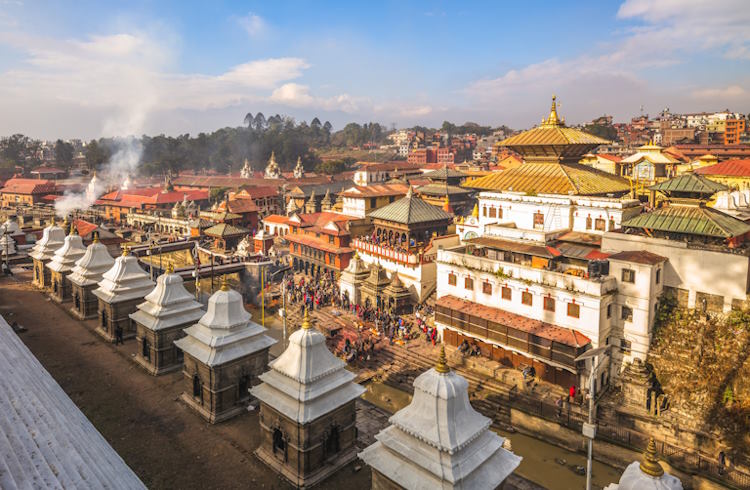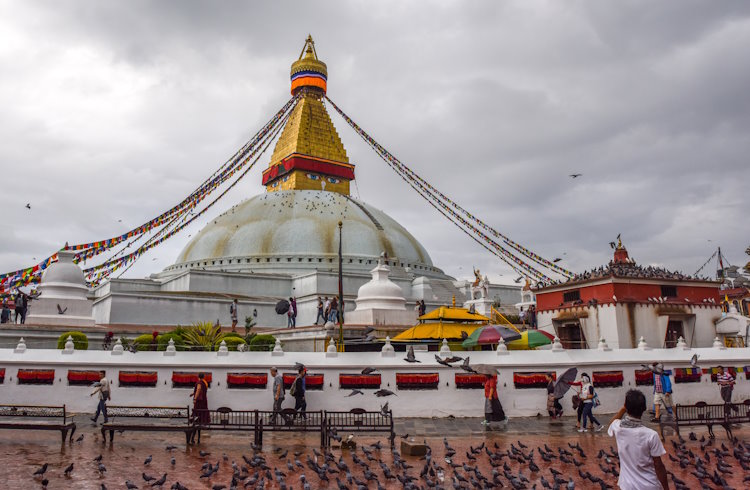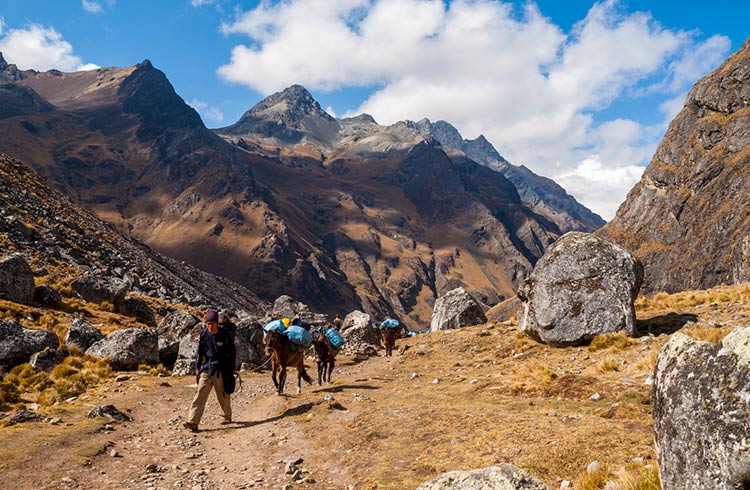8 Temples and Cultural Landmarks to See in Nepal
You don't need to go far from Kathmandu to experience some of Nepal's top cultural sites. Nomad Ronan shares his favorites – famous temples, enormous stupas, dramatically situated monasteries, and former palaces.
 Photo © Getty Images / Jui-Chi Chan
Photo © Getty Images / Jui-Chi Chan
Best known for its extraordinary scenery and epic hiking, Nepal also boasts a trove of photogenic and culturally significant landmarks, including former royal hubs, mountainside monasteries, and temples commandeered by animals. Here’s a guide to eight of Nepal’s most famous temples and finest historic sites.
- Swayambhunath, aka “Monkey Temple” (Kathmandu)
- Durbar Square (Bhaktapur)
- Boudhanath Stupa (Kathmandu)
- Shree Muktinath Temple (Mustang)
- Pashupatinath Temple (Kathmandu)
- Kopan Monastery (Budhanilkantha)
- Changu Narayan Temple
- Manakamana Temple (Gandaki)
Swayambhunath, aka “Monkey Temple” (Kathmandu)
For several minutes I had a stand-off with a persistent monkey, who, when I turned to photograph the sprawl of Kathmandu, would sneak up behind me as if set to pounce. Eventually, I realized he was just playful, rather than dangerous. The same could be said for the hundreds of other primates that swarm Swayambhunath, also known as Monkey Temple.
Looming above the historic heart of Kathmandu, this is perhaps the city’s busiest tourist attraction due to its commanding architecture, mesmerizing views of the city and surrounding peaks, and the exotic allure of those cheeky monkeys. Swayambhunath is also a hugely important religious site. This 1,500-year-old UNESCO World Heritage Site has long attracted Buddhist pilgrims, who climb its many stairs to pray to Lord Buddha.

Durbar Square (Bhaktapur)
For more than a millennia, the pretty city of Bhaktapur (about 8mi/13km from Kathmandu) has been centered around Durbar Square. This plaza, in turn, is defined by its most commanding resident, the Palace of 55 Windows. I never stopped to count, and confirm the accuracy of that name, but this well-preserved palace kept me enthralled for hours.
Built at the turn of the 18th century, it’s a delightful complex decorated by intricate woodwork and stonemasonry, the creative calling cards of the Newari people. Back then it housed the ruling family of the Malla Dynasty. Nowadays visitors walk between two giant lion statues to enter the site, which has been converted into the National Art Gallery, showcasing Nepalese artforms such as brasswork and Thangka paintings.
Boudhanath Stupa (Kathmandu)
A late afternoon storm was about to besiege Kathmandu when I peered down a narrow alley to spot a lofty, gilded tower glowing in the gloom. The deep-grey skies only made it more dramatic. Two eyes stared straight at me – painted on the base of Boudhanath, which is among the largest stupas in Nepal, and a major attraction for visitors.
Built in the 1300s, Boudhanath is one of seven ancient structures spread through the Kathmandu Valley which collectively form a UNESCO World Heritage Site. Now surrounded by small cafes, restaurants, and shops, this stupa sits atop a whitewashed dome, which also gleams in the daylight, or in the evening when Boudhanath is illuminated by spotlights.

Shree Muktinath Temple (Mustang)
Few religious sites have a more memorable location than Shree Muktinath Temple. It’s setting will, quite literally, take your breath away, due to the low levels of oxygen at 12,467ft (3,800m) above sea level, deep in the snow-draped Himalayan mountains.
It’s a holy site for Buddhists and Hindus, and adherents of both faiths have long been drawn here to see its Shaligram, a sacred form of rock. Fossils, collected from the nearby Kali Gandaki River, are believed to be the stone embodiments of Lord Vishnu.
Shree Muktinath is also frequented by hikers, due to its location on the Annapura Circuit, one of Nepal’s busiest trekking routes. This path begins at Besisahar, about 25mi (40km) east of Pokhara city, and then ascends to the Thorung La Pass, at a startling elevation of 17,650ft (5,380m).
Pashupatinath Temple (Kathmandu)
Pashupatinath is blessed by the sacred waters of the adjacent Bagmati River, which begins in the peaks north of Kathmandu before flowing south to India. Nepal’s holiest Hindu temple, and a key site of pilgrimage for centuries, it is so old that its exact origins aren’t clear. Some accounts place it at up to 1,500 years old.
Pashupatinath does not allow non-Hindus to enter its inner sanctum. But by hiring a local guide, for about US $10 in addition to the US $10 entry ticket, I was shepherded through the outer buildings, which allow tourists, to the best elevated points from where I could peer down into the main temple. On a platform by the river, I saw a smoldering pile of ash. “Cremation,” my guide said, in reference this site’s long tradition of sending the dead to the afterlife.
Kopan Monastery (Budhanilkantha)
Residing on a forested hilltop just north of Kathmandu, Kopan Monastery is wonderfully serene. Visitors are attracted here by the tranquility or, as I was, by its bold, polychromatic design.
This is one of the few Buddhist monasteries near the Nepalese capital which allows travelers to stay and study within the complex. I spotted several foreigners praying amid throngs of local monks while I photographed its maroon and cream exterior, and the rainbow-hued murals which cover the prayer hall.

Changu Narayan Temple
The vast, verdant Kathmandu Valley stretches out beneath Changu Narayan Temple, as the Himalayan peeks loom large and frosty in the distance. Similar to Shree Muktinath, this temple is worth visiting for its dramatic location alone, perched on a forested peak, about 5,050ft (1,540m) above sea level, roughly 6mi (10km) east of Kathmandu.
This UNESCO site, dedicated to Hindu god Vishnu, is widely considered the country’s oldest temple, dating back at least 1,600 years. That’s also the age of several of its key artefacts – a winged Garuda statue near the temple’s entrance, an inscribed stone tablet, and several weathered Hindu idols.
The main temple building is not nearly as old, having been razed by fire in the early 1700s. But what was then built is a wonder of Nepalese craftsmanship, embellished by complex woodwork and stonemasonry.
About an hour’s drive from downtown Kathmandu, Changu Narayan is best reached by hiring a private vehicle. To make best use of your time, do a loop north through Kopan Monastery to Changunarayan, and south back through Bhaktapur to your hotel.
Manakamana Temple (Gandaki)
Many travelers fly between Kathmandu and the stunning lakeside city of Pokhara. I’m so happy I instead chose the seven-hour bus ride. Although it’s at times bumpy and uncomfortable, the striking views of lakes, valleys, rivers, and peaks are burned into my memory.
Traveling by road also allows the option to stop midway at Manakamana Temple. It can be easily accessed in about 10 minutes by catching a cable car from Kurintar, alongside the Kathmandu-to-Pokhara highway. At the end of this scenic ride, travelers encounter a two-tiered pagoda that anchors a courtyard decorated by timeworn Hindu statues.
Related articles
Simple and flexible travel insurance
You can buy at home or while traveling, and claim online from anywhere in the world. With 150+ adventure activities covered and 24/7 emergency assistance.
Get a quote

No Comments